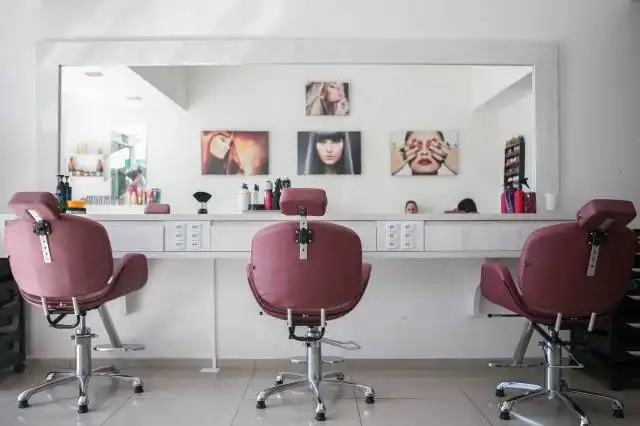Start your own Makeup Artist Business
Spin Magic with Makeup: Painting Faces with a Palette of Possibilities
| Updated


MAKEUP ARTIST BUSINESS
Toying with the idea of a Makeup Artist Business? Fantastic! In this beauty-focused enterprise, you work your magic by transforming ordinary muggles into breathtaking beauties or gruesome ghouls, depending on the occasion. Delve into an art that's not just about coloring faces, but about understanding skin tones, textures, and facial structures. Be the architect behind a bride's glow, an actor's era-appropriate look, or a teenager's prom-night sparkle. Embrace this opportunity to make every client's day special with just a flick of your makeup brush.
Jump to Business Plan
RELATED BUSINESS IDEAS
Browse ALL Health & Beauty Innovations Business Ideas
Discover Your Perfect Domain
Unlock the door to your online success with our hand-picked selection of premium domain names. Whether you're starting a new venture or rebranding an existing one, the right domain can set the tone for your digital presence. Browse through our curated list, each with its unique potential to enhance your brand's visibility and credibility.
MAKEUP ARTIST MINI BUSINESS PLAN
This a quick reality check to help you identify the strengths and weaknesses of your business concept before you dive in.
Expected Percent Margin:
- Gross Margin: 70-80%
- Net Profit Margin: 25-35%
Earnings Expectations:
- Daily Earnings: $100 - $300
- Weekly Earnings: $500 - $1,500
- Monthly Earnings: $2,000 - $6,000
- Annual Earnings: $24,000 - $72,000
Actions to Hit Those Numbers:
Equipment and Inventory:
- Initial Investment: Anticipate costs of $2,000 - $5,000 for professional-grade makeup and tools.
- Regular Replacement: Replace/upgrade makeup and equipment regularly to maintain quality.
Training and Credentialing:
- Certification Costs: Factor in the cost to get certified as a professional makeup artist if not already licensed.
- Continuing Education: Budget for ongoing training/workshops to keep pace with industry trends and techniques.
Marketing and Customer Acquisition:
- Portfolio Building: Aim to do 3-5 free/inexpensive jobs to build your portfolio and gain testimonials.
- Social Media: Use Instagram, Pinterest, and YouTube to showcase your work and attract clients.
- Networking: Regularly attend industry events and network with potential clients and collaborators.
Pricing and Sales:
- Pricing Strategy: Establish competitive rates for your region, skill level, and the complexity of the work.
- Upsells: Consider offering “add-on” services like skincare consultations or product sales.
Overhead and Cost Control:
- Travel: Save on rental costs by working on-site or from home, but factor in travel expenses.
- Supplies: Order supplies in bulk or during sales to save costs.
Business Operations:
- Booking Schedule: Strive to book 2-4 clients per day, depending on service complexity.
- Off-peak Revenue Streams: Consider offering makeup classes or online consultations for added income.
These estimates are generalized and actual numbers can vary significantly based on location, specialization, economic conditions, and individual business strategies. Always consult with a financial advisor before starting your business.
NOT WHAT YOU HAD IN MIND? Here are more ideas



Browse ALL Health & Beauty Innovations Business Ideas
Grab Your Business Website Name
Before you get caught up in the whirlwind of setting up your business, invest in a domain name. It's a small but significant step that lays the foundation for your brand and makes it easier for customers to find and trust you. Just like you wouldn't build a house without securing the land first, don't build a business without securing your domain name.
"Why? Can't that wait?" Here's why it shouldn't
Step 1: Determine if the Business is the Right Endeavor
Breakdown of Startup Expenses
Before starting a makeup artist business, it is important to understand the startup costs associated with the business. This includes the cost of makeup supplies, a website, business cards, and any other marketing materials. Additionally, you may need to purchase a license or permit to operate a business in your area. It is important to research the costs associated with each of these items and create a budget for the startup costs.
Breakdown of Ongoing Expenses
After the initial startup costs, there are ongoing expenses associated with running a makeup artist business. This includes the cost of supplies, such as makeup, brushes, and other tools. Additionally, you may need to pay for advertising and marketing materials, such as business cards and flyers. You may also need to pay for insurance and other business-related expenses. It is important to create a budget for these ongoing expenses and to track them regularly.
Examples of Ways to Make Money
Once you have determined the startup and ongoing expenses associated with your makeup artist business, it is important to understand how you will make money. This includes understanding the different services you can offer, such as makeup application, makeup lessons, and makeup parties. Additionally, you may want to consider selling makeup products or offering makeup services for special events, such as weddings and proms. Understanding the different ways you can make money will help you create a successful business plan.
Step 2: Name the Business
- Brainstorm ideas: Start by brainstorming ideas for a business name. Think of words that are related to makeup, beauty, and artistry. Consider using a combination of words, or even a phrase, to create a unique name.
- Research the name: Once you have a few ideas, research them to make sure they are not already taken. Check to see if the domain name is available and if the social media handles are available.
- Consider the message: When choosing a name, consider the message you want to convey. Think about how the name will be perceived by potential customers and how it will fit into your overall branding.
- Get feedback: Ask friends and family for their opinion on the name. Get feedback from potential customers and industry professionals to see what resonates with them.
- Make a decision: After considering all the feedback, make a decision on the name. Once you have chosen a name, you can start to create a logo and other branding materials.
Step 3: Create a Business Plan
Creating a business plan is essential for any business, and a makeup artist business is no exception. A business plan serves as a roadmap for the future of the business, and can help to ensure success. It should include a detailed description of the business, its goals, and how it will be financed. It should also include a market analysis, a financial plan, and a description of the products and services the business will offer.
Writing a Business Plan
Writing a business plan can be a daunting task, but it is an important step in the process of starting a business. It is important to include a detailed description of the business, its goals, and how it will be financed. It should also include a market analysis, which should include an analysis of the competition, an analysis of the target market, and a description of the products and services the business will offer. Additionally, the business plan should include a financial plan, which should include a budget, a list of expenses, and a description of the expected revenue. Finally, the business plan should include a description of the management team and their qualifications.
Benefits of a Business Plan
Having a business plan is essential for any business, and a makeup artist business is no exception. A business plan can help to ensure success by providing a roadmap for the future of the business. It can also help to attract investors and secure financing. Additionally, having a business plan can help to keep the business organized and on track. Finally, a business plan can help to ensure that the business meets its goals and objectives.
Step 4: Obtain Licenses and Permits
Before you can start your makeup artist business, you will need to obtain the necessary licenses and permits. Depending on the state you are operating in, you may need to apply for a business license, a sales tax permit, and a health permit. You may also need to obtain a license to practice cosmetology, depending on the services you are offering. It is important to research the specific requirements for your state and city to ensure that you are in compliance with all of the necessary regulations.
Applying for Licenses and Permits
Once you have determined the licenses and permits you need, you can begin the process of applying for them. Most of the applications can be completed online, but you may need to provide additional documentation, such as proof of identity or proof of business ownership. Depending on the state and city, the application process can take anywhere from a few days to a few weeks. Once you have been approved for the necessary licenses and permits, you will be ready to move on to the next step.
Cost of Licenses and Permits
The cost of obtaining the necessary licenses and permits will vary depending on the state and city you are operating in. Generally, you can expect to pay anywhere from $50 to $200 for the necessary licenses and permits. In some cases, you may also need to pay an annual fee to maintain the license or permit. It is important to factor in the cost of licenses and permits when calculating your startup costs.
Step 5: Set Up Accounting
Setting up accounting for your makeup artist business is an important step to ensure that you can track your income and expenses. It is important to set up a system that is easy to use and understand, so that you can keep track of your finances and make sure that you are staying on top of your taxes.
Setting Up a Bank Account
The first step in setting up accounting for your makeup artist business is to set up a separate bank account. This will allow you to keep your business finances separate from your personal finances, and will make it easier to track your income and expenses. You should also look into setting up a credit card specifically for business purchases, as this will help you keep track of your business expenses.
Setting Up an Accounting System
Once you have set up a bank account for your business, you will need to set up an accounting system. This system should be tailored to your business, and should include a way to track your income and expenses. You should also look into setting up a system for tracking your taxes, as this will help you stay on top of your tax obligations.
Hiring an Accountant
If you are not comfortable setting up an accounting system on your own, you may want to consider hiring an accountant. An accountant can help you set up an accounting system that is tailored to your business, and can also help you with filing your taxes. This can be a great way to ensure that your finances are in order, and that you are staying on top of your taxes.
Step 6: Purchase Equipment
When starting a makeup artist business, it is important to purchase the necessary equipment to ensure the best quality of services. Depending on the type of services offered, the equipment needed can vary. For example, if the business offers services such as airbrush makeup, a compressor and airbrush gun will be necessary. Additionally, makeup brushes, sponges, and other tools are essential for makeup application. It is important to research the best quality products that will last and provide the best results.
Cost of Equipment
The cost of equipment will vary depending on the type of services offered. Generally, the cost of equipment can range from a few hundred dollars to a few thousand. It is important to research the different types of equipment available and compare prices to find the best deal. Additionally, it is important to factor in the cost of any additional supplies such as makeup, brushes, and sponges.
Where to Purchase Equipment
When purchasing equipment, it is important to find a reliable source. Many makeup artist businesses purchase their equipment from beauty supply stores or online retailers. Additionally, many beauty supply stores offer discounts for makeup artist businesses. It is important to research the different options available and find the best deal.
Financing Options
For those who are unable to purchase the necessary equipment upfront, there are financing options available. Many beauty supply stores offer financing options with no interest for a certain period of time. Additionally, there are many online lenders that offer financing options for small businesses. It is important to research the different financing options available and find the best option for the business.
Step 7: Market the Business
Once you have your business up and running, it’s time to get the word out. There are a few different ways to market your business, and it’s important to find the right mix for you.
Social media is one of the most effective and cost-efficient ways to market your business. Platforms like Instagram, Facebook, and Twitter are great for connecting with potential clients, and you can also use them to showcase your work. You can also use these platforms to advertise special offers and discounts.
Networking is another great way to market your business. Attend local events and meet-ups related to the beauty industry, and make sure to bring business cards and promotional materials. You can also join online forums and groups related to makeup artistry, and use them to connect with potential clients.
Word-of-mouth is also an important marketing tool. Ask your existing clients to spread the word about your business, and offer incentives like discounts or free services for referrals. You can also offer discounts to first-time clients to encourage them to try your services.
Finally, you can also use traditional advertising methods like print ads and radio spots. These methods can be expensive, but they can be effective if you target the right audience.
Step 8: Network
Network with other makeup artists and beauty professionals to create a strong network of contacts. This will help you to find potential clients, collaborate with other professionals, and stay up to date with the latest trends and techniques.
Attend Events
Attend industry events such as trade shows, conferences, and beauty expos. These events are great opportunities to meet other professionals in the industry, learn about new products and techniques, and make connections. Make sure to bring business cards and other promotional materials to give to potential clients and partners.
Join Professional Organizations
Joining professional organizations such as the Professional Beauty Association (PBA) or the National Association of Professional Makeup Artists (NAPMA) can help you stay connected to the industry and provide you with access to resources, training, and networking opportunities.
Utilize Social Media
Social media is a great way to promote your business and connect with potential clients. Create a website and social media accounts for your business and use them to showcase your work, promote events, and interact with customers. You can also use social media to connect with other professionals in the industry and stay up to date with the latest trends.
Connect with Local Salons and Spas
Reach out to local salons and spas to see if they are interested in working with you. You can offer to provide makeup services for their customers or collaborate on events and promotions. This is a great way to build your portfolio and gain experience.
Step 9: Launch the Business
Launching a business is an exciting time. It is the culmination of all the hard work and planning that has gone into starting the business. It is important to have a plan in place for the launch of the business, including marketing and advertising strategies, as well as a plan for how to handle customer inquiries and orders.
Create a Website
Creating a website is essential for any business, and a makeup artist business is no exception. A website should include information about the services offered, pricing, and contact information. It should also include a portfolio of the artist's work, as well as any reviews or testimonials from previous clients. Additionally, the website should be optimized for search engines so that potential customers can find the business easily.
Market the Business
Marketing the business is essential for success. This can include creating social media accounts, running ads, and attending events to promote the business. Additionally, word-of-mouth marketing is a great way to get the word out about the business. It is important to create a brand identity and to use consistent messaging across all marketing channels.
Prepare for Orders
Once the business is launched, it is important to be prepared to handle customer inquiries and orders. This includes having a system in place for taking orders, processing payments, and shipping orders. Additionally, it is important to have a customer service plan in place in case customers have any questions or issues.
Celebrate
Finally, it is important to take the time to celebrate the launch of the business. This can include throwing a launch party, or simply taking a moment to appreciate all the hard work that has gone into starting the business. Celebrating the launch of the business is a great way to start off on the right foot.
EXPLORE MORE CATEGORIES
Browse ALL Business Idea Categories
TAKE THE NEXT STEPS










